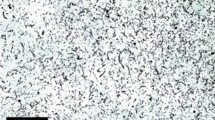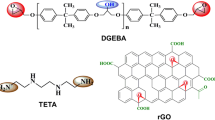Abstract
Low permittivity materials are crucial for achieving high integration in circuit boards. While epoxy resins (EP) have excellent comprehensive properties, their permittivity does not meet the requirements for electronic packaging applications. In this study, we incorporated two types of Polyhedral oligomeric silsesquioxane (POSS) into EP and compared their effects on the dielectric, thermal, and mechanical properties of EP/POSS composites. The results demonstrate that EP/Ge-POSS composites exhibit superior dielectric properties compared to EP/Ao-POSS composites. Notably, the permittivity of EP/Ge-POSS composites is significantly reduced to 2.8, a 19% decrease compared to neat EP. Additionally, the mechanical properties of EP/Ge-POSS composites show remarkable improvement. For instance, the impact strength, bending strength, and tensile strength increase by 42.3%, 28.9%, and 18.9%, respectively, in EP/Ge-POSS-5wt% composites, compared to pure EP. The addition of Ge-POSS nano-particles has minimal impact on the thermal properties of the composites.










Similar content being viewed by others
Data availability
The data that support the findings of this study are not openly available and are available from the corresponding author upon reasonable request.
References
N. Hafezeh, W. **n, H. Yuan, Carbon fiber-reinforced composites based on an epoxy resin containing Schiff base with intrinsic anti-flammability, good mechanical strength and recyclability. Eur. Polym. J. 194, 112166 (2023)
P.J. Yang et al., Effect of coal tar pitch modification on the structure and char yield of pyrolysis epoxy resin carbons. Diam. Relat. Mater. 137, (2023)
F. Zhu et al., Synthesis and curing properties of multifunctional castor oil-based epoxy resin. Polym. Test. 122, 108017 (2023)
S. Guanqing et al., Shrinkage stress of thermal cured epoxy resin reduced by addition of functional hollow microspheres. Prog. Org. Coat. 178, 107466 (2023)
L. Haichuan et al., Study on a new cementitious material waterborne modified epoxy resin under sealed conditions for oil and gas wells. Constr. Build. Mater. 387, 131588 (2023)
H. Du et al., Surfactant-free emulsion of epoxy resin/sodium alginate for achieving robust underwater superoleophobic coating via a combination of phase separation and biomineralization. J. Colloid Interface Sci. (2023). https://doi.org/10.1016/j.jcis.2023.03.166
B. Yunfeng et al., Effects of MOFs-derived Ni@NC/CNT nanocomposites on impermeability and microwave absorption of modified epoxy resin coatings on cement-based materials. Constr. Build. Mater. 383, 131337 (2023)
C. Leistner et al., Shrinkage behavior of Araldite epoxy resin using Archimedes’ principle. Polym. Test. (2018). https://doi.org/10.1016/j.polymertesting.2018.03.031
C.F. Zhao et al., Compression mechanics for carbon-fiberreinforced epoxy resin composites under inplane and out-of-plane Quasi-Static and dynamic loadings. Mech. Compos. Mater. (2023). https://doi.org/10.1007/s11029-023-10112-y
J.A. Tenreiro Machado, A.M. Lopes, R. de Camposinhos, Fractional-order modelling of epoxy resin. Philos. Trans. R. Soc. A (2020). https://doi.org/10.1098/rsta.2019.0292
A. Sut et al., Synergy in flame-retarded epoxy resin. J. Therm. Anal. Calorim. (2016). https://doi.org/10.1007/s10973-016-5934-4
J.C. Capricho, B. Fox, N. Hameed, Multifunctionality in epoxy resins. Polym. Rev. (2019). https://doi.org/10.1080/15583724.2019.1650063
C. Niu et al., Mechanical properties of epoxy resin composites modified by epoxy styrene-butadiene latex. J. Appl. Polym. Sci. (2023). https://doi.org/10.1002/app.54002
A. Ahrens et al., Catalytic disconnection of C–O bonds in epoxy resins and composites. Nature (2023). https://doi.org/10.1038/s41586-023-05944-6
X. Zhang et al., Epoxy resin/hollow glass microspheres composite materials with low dielectric constant and excellent mechanical performance. J. Appl Polym Sci. (2022). https://doi.org/10.1002/app.52787
S. Wang et al., Nano-silica reinforced epoxy resin/nano-rubber composite material with a balance of stiffness and toughness. High Perform. Polym. (2021). https://doi.org/10.1177/0954008320988752
H. Luo et al., Investigation of properties of nano-silica modified epoxy resin films and composites using RFI technology. Compos. Part B: Eng. 155, 288–298 (2018)
M. Toselli et al., In situ thermal reduction of graphene oxide forming epoxy nanocomposites and their dielectric properties. Polym. Compos. 36(2), 294–301 (2015)
A. Wolk et al., Graphene oxide as flexibilizer for epoxy amine resins. Prog. Org. Coat. (2018). https://doi.org/10.1016/j.porgcoat.2018.05.028
M. Sabet et al., Impact of graphene oxide on epoxy resin characteristics. High Perform. Polym. (2020). https://doi.org/10.1177/0954008320943929
L. Yuan et al., Preparation and properties of mullite-bonded porous fibrous mullite ceramics by an epoxy resin gel-casting process. Ceram. Int. (2017). https://doi.org/10.1016/j.ceramint.2017.01.062
G. Feng et al., Pressure field assisted polycondensation nonaqueous precipitation synthesis of Mullite Whiskers and their application as epoxy resin reinforcement. Polymers (2019). https://doi.org/10.3390/polym11122007
C. Pan et al., Enhanced through-plane thermal conductivity of PTFE composites with hybrid fillers of hexagonal boron nitride platelets and aluminum nitride particles. Compos. B Eng. 153, 1–8 (2018)
Z. Wang et al., The investigation of the effect of filler sizes in 3D-BN skeletons on thermal conductivity of epoxy-based composites. Nanomaterials (2022). https://doi.org/10.3390/nano12030446
C. Pan et al., Improved thermal conductivity and dielectric properties of hBN/PTFE composites via surface treatment by silane coupling agent. Compos. B Eng. 111, 83–90 (2017)
Z. Wang et al., Simultaneously enhanced dielectric properties and through-plane thermal conductivity of epoxy composites with alumina and boron nitride nanosheets. Sci. Rep. (2021). https://doi.org/10.1038/s41598-021-81925-x
C. Pan et al., Investigation of the through-plane thermal conductivity of polymer composites with in-plane oriented hexagonal boron nitride. Int. J. Heat Mass Transf. 120, 1–8 (2018)
Y. Zhao et al., Facile preparation of graphene oxide for low-κ epoxy nanocomposites with improved thermal stability. J. Mater. Sci.: Mater. Electron. 31(1), 310–316 (2020)
Q. Lyu et al., Imidazolium Ionic liquid modified graphene oxide: as a reinforcing filler and catalyst in Epoxy Resin. Polymers 9(12), 447 (2017)
J. Lu et al., Preparation and properties of Hollow Glass microspheres/dicyclopentadiene phenol epoxy resin composite materials. Materials (2023). https://doi.org/10.3390/ma16103768
M. Wang et al., Progress in the synthesis of bifunctionalized polyhedral oligomeric silsesquioxane. Polymers (2019). https://doi.org/10.3390/polym11122098
Y. Shi et al., Effect of POSS on the Dielectric properties of thermally aged epoxy resin insulating materials. IEEE Trans. Dielectr. Electr. Insul. (2022). https://doi.org/10.1109/TDEI.2022.3194492
K. Mishra, G. Pandey, R.P. Singh, Enhancing the mechanical properties of an epoxy resin using polyhedral oligomeric silsesquioxane (POSS) as nano-reinforcement. Polym. Test. (2017). https://doi.org/10.1016/j.polymertesting.2017.06.031
H. Chi et al., Enhancing the mechanical strength and toughness of epoxy resins with linear POSS nano-modifiers. Nanoscale Adv. (2022). https://doi.org/10.1039/D1NA00757B
J.D. Lichtenhan, D.A. Hildebrandt, L.J. Lancaster, The thrombogenic activity of POSS silanols. Dalton Trans. (2017). https://doi.org/10.1039/C7DT00487G
W. Huaming et al., Organic–Inorganic Polyimides with POSS Cages in the Main Chains: An Impact of POSS R Groups on Morphologies and Properties. ACS Appl. Polym. Mater. (2023)
T. Hao et al., Preparation and characterization of polyurethane/POSS hybrid aqueous dispersions from mono-amino substituted POSS. Polym Bull (2016). https://doi.org/10.1007/s00289-016-1727-y
P. Chang et al., A design of shape memory networks of poly(ε-caprolactone)s via POSS-POSS interactions. Polym. Adv. Technol. (2018). https://doi.org/10.1002/pat.4509
H. Zhendong et al., SLA printing of POSS-containing, bio-based composites with low dielectric constant and shape-memory function. Compos. Commun. 39, 101566 (2023)
J. Zhou et al., Study on the effects of soluble POSS on chain disentanglement in UHMWPE polymerization. Polymer (2022). https://doi.org/10.1016/j.polymer.2022.124561
D. Chen et al., Porous NIR photoluminescent silicon nanocrystals-POSS composites. Adv. Funct. Mater. (2016). https://doi.org/10.1002/adfm.201601251
N.T. Kilic et al., Compatibilization of PLA/PBAT blends by using Epoxy-POSS. J. Appl. Polym. Sci. (2018). https://doi.org/10.1002/app.47217
T.F. Baumann et al., Synthesis and characterization of novel PDMS nanocomposites using POSS derivatives as cross-linking filler. J. Polym. Sci., Part A: Polym. Chem. 47(10), 2589–2596 (2009)
A.H. Korayem et al., A review of dispersion of nanoparticles in cementitious matrices: Nanoparticle geometry perspective. Constr. Build. Mater. (2017). https://doi.org/10.1016/j.conbuildmat.2017.06.164
G.-L. Zhu et al., Improving dam** properties and thermal stability of epoxy/polyurethane grafted copolymer by adding glycidyl POSS. Chin. J. Polym. Sci. 36(11), 1297–1302 (2018)
Y. Xu et al., Greatly improving thermal stability of silicone resins by modification with POSS. Polym. Degrad. Stab. (2020). https://doi.org/10.1016/j.polymdegradstab.2020.109082
L. Liu et al., A new mechanism for the low dielectric property of POSS nanocomposites: the key role of interfacial effect. Phys. Chem. Chem. Phys. 19(22), 14503–14511 (2017)
Q. Jiang et al., A unique “cage–cage” shaped hydrophobic fluoropolymer film derived from a novel double-decker structural POSS with a low dielectric constant. J. Mater. Chem. C (2015). https://doi.org/10.1039/C5TC02432C
J. Wang et al., Preparation of Low-k poly(dicyclopentadiene) nanocomposites with excellent comprehensive properties by adding larger POSS. Chem. Eng. J. (2022). https://doi.org/10.1016/j.cej.2022.135737
J. ** effect on the properties of two-component crosslinked epoxy resin. J. Mol. Graph. Model. (2021). https://doi.org/10.1016/j.jmgm.2021.107961
W. Jian et al., High-performance low-k poly(dicyclopentadiene) nanocomposites as achieved via reactive blending with norbornene-functionalized larger POSS. Macromol. Mater. Eng. (2023)
X. Zeng et al., Structure-induced variation of thermal conductivity in epoxy resin fibers. Nanoscale (2017). https://doi.org/10.1039/C7NR03717A
M.S. Windberger et al., Temperature-triggered/switchable thermal conductivity of epoxy resins. Polymers (2020). https://doi.org/10.3390/polym13010065
T. Na et al., Enhanced thermal conductivity of fluorinated epoxy resins by incorporating inorganic filler. React. Funct. Polym. (2018). https://doi.org/10.1016/j.reactfunctpolym.2018.05.004
C. Yue et al., Vitrimeric silicone composite with high thermal conductivity and high repairing efficiency as thermal interface materials. J. Colloid Interface Sci. 620, 273–283 (2022)
T. Heid, M. Frechette, E. David, Enhanced electrical and thermal performances of nanostructured epoxy/POSS composites. IEEE Trans. Dielectr. Electr. Insul. 23(3), 1732–1742 (2016)
Z. Zhang et al., Synthesis of eugenol-functionalized polyhedral oligomer silsesquioxane for low-k bis maleimide resin combined with excellent mechanical and thermal properties as well as its composite reinforced by silicon fiber. Chem. Eng. J. 439, 135740 (2022)
H.P.P.V. Shanmugasundram, E. Jayamani, K.H. Soon, A comprehensive review on dielectric composites: classification of dielectric composites. Renew. Sust. Energy Rev. 157, 112075 (2022)
Z. Geng et al., Ultra low dielectric constant soluble polyhedral oligomeric silsesquioxane (POSS)–poly(aryl ether ketone) nanocomposites with excellent thermal and mechanical properties. J. Mater. Chem. C 2(6), 1094–1103 (2013)
Z. Chen et al., Conductive TiO2 nanorods via surface coating by antimony doped tin dioxide. Mater. Chem. Phys. 225, 181–186 (2019)
C. **n et al., Synthesis of EP-POSS mixture and the properties of EP-POSS/epoxy, SiO2/epoxy, and SiO2/EP-POSS/epoxy nanocomposite. J. Appl. Polym. Sci. 130(2), 810–819 (2013)
J.J. Chruściel, E. Leśniak, Modification of epoxy resins with functional silanes, polysiloxanes, silsesquioxanes, silica and silicates. Prog. Polym. Sci. 41, 67–121 (2015)
N. Saba et al., A review on dynamic mechanical properties of natural fibre reinforced polymer composites. Constr. Build. Mater. 106, 149–159 (2016)
Q. Sun et al., High performance epoxy resin with ultralow coefficient of thermal expansion cured by conformation-switchable multi-functional agent. Chem. Eng. J. (2022). https://doi.org/10.1016/j.cej.2022.138295
Acknowledgements
The authors wish to thank the support of the National Natural Science Foundation of China (Grant No. 51673154 and No. 52273254) and the Fundamental Research Funds for the Central Universities (Grant Number: 2023-vb-001).
Funding
This work was supported by The National Natural Science Foundation of China,51673154,Chuanxi **ong, Fundamental Research Funds for Central Universities of the Central South University,2023-vb-001,the National Natural Science Foundation of China,52273254,Chuanxi **ong.
Author information
Authors and Affiliations
Contributions
All authors made equal contributions to researching data, discussion, and analysis of the content of the manuscript. KS: writing-original draft, visualization, data curation, investigation. XZ: visualization. HQ: methodology investigation, data curation, formal analysis. CD: writing-review & editing. XN, DC, RF: supervision. KS: conceptualization, funding acquisition, supervision, writing-review & editing. KS and XZ contributed equally to this work.
Corresponding author
Ethics declarations
Conflict of interest
The authors declare that they have no known competing financial interests or personal relationships that could have appeared to influence the work reported in this paper.
Ethical approval
Not applicable in this work.
Additional information
Publisher's Note
Springer Nature remains neutral with regard to jurisdictional claims in published maps and institutional affiliations.
Rights and permissions
Springer Nature or its licensor (e.g. a society or other partner) holds exclusive rights to this article under a publishing agreement with the author(s) or other rightsholder(s); author self-archiving of the accepted manuscript version of this article is solely governed by the terms of such publishing agreement and applicable law.
About this article
Cite this article
Shen, K., Zhang, X., Qin, H. et al. Epoxy resin/POSS nanocomposites with low permittivity and excellent mechanical properties. J Mater Sci: Mater Electron 35, 21 (2024). https://doi.org/10.1007/s10854-023-11758-z
Received:
Accepted:
Published:
DOI: https://doi.org/10.1007/s10854-023-11758-z




